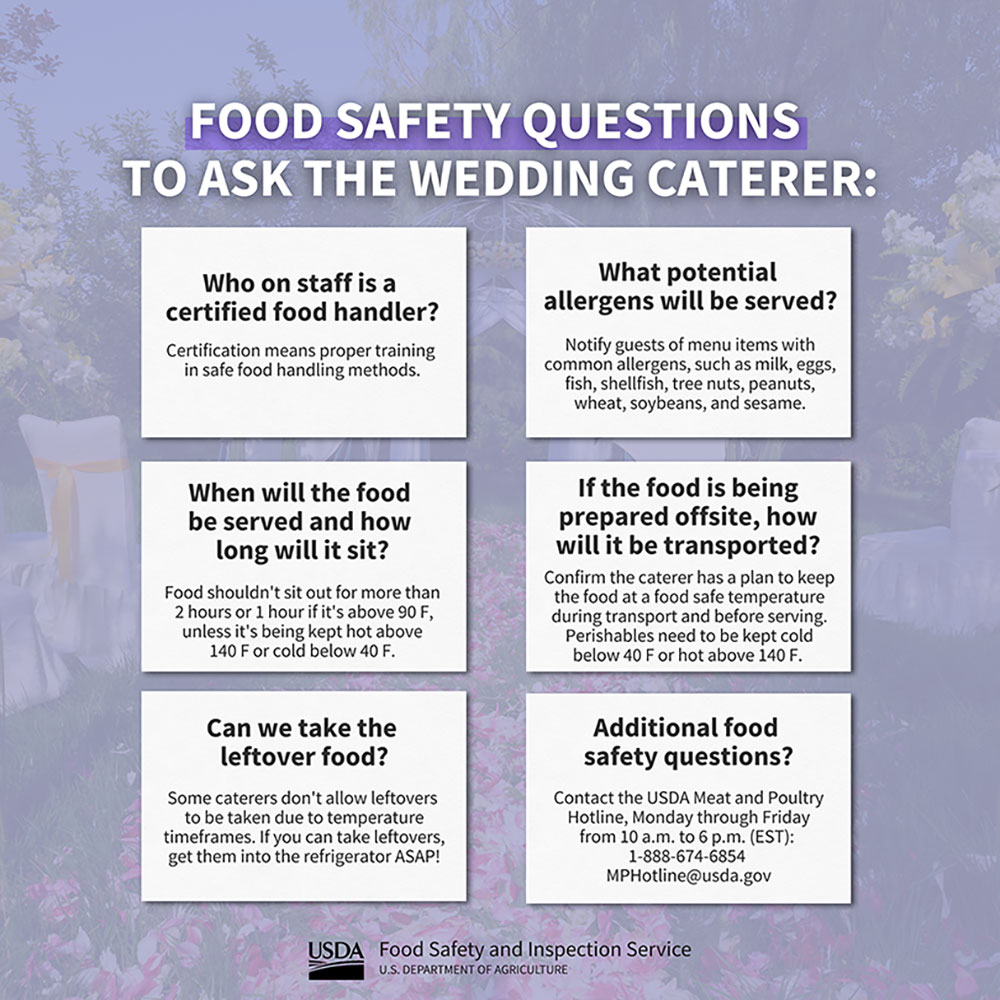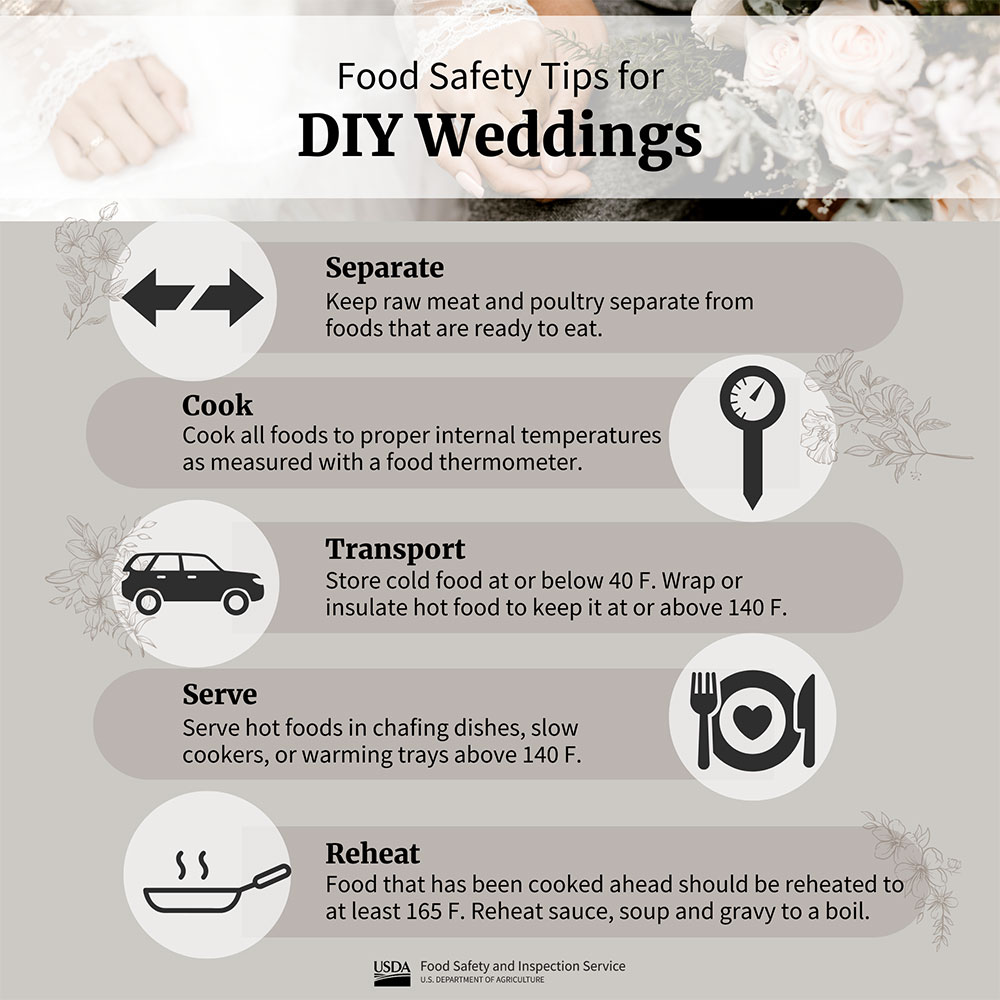
Winter, spring, summer or fall – no matter the season, one of the biggest components to a wedding celebration is the food! Weddings traditionally serve food prepared by a catering vendor or homemade by friends and family. Whichever avenue you choose, make sure that food safety is at the top of your checklist during the menu planning stage.
If you’re hiring a caterer, it’s important to select a company that has all the necessary food licensing with a staff trained in food safety, or an individual who has acquired their food safety certification. Here are some questions to ask the caterer to ensure they have food safety top of mind:
- Where will the food be prepared?
- What steps are taken during food preparation to avoid cross-contamination?
- If the food is being prepared offsite, how will it be transported to the wedding venue?
- How and where will it be stored until it is time to serve?
- When will the food be served and how long will it sit?
- Will food temperatures be monitored?
- Can we take the leftover food? If so, how will it be packaged and stored until the end of the event?
These questions will help you confirm that the caterer has a plan to prepare, transport, keep and serve your wedding food at a food safe temperature. It is not safe for food to sit at room temperature for more than 2 hours, or 1 hour if it’s being served in an area above 90 degrees F, unless it is being kept hot above 140 degrees F or cold below 40 degrees F. Some caterers won’t allow leftovers to be taken due to temperature timeframes. If you can take leftovers, get them into the refrigerator ASAP!
To avoid allergic reactions or food sensitivities from occurring at the event, the caterer should receive a list that contains guests’ allergies prior to the event. The list can also help to provide information about other dietary preferences such as vegan, vegetarian and gluten-free.
If you plan to DIY (do it yourself) your wedding food, follow these important steps to make sure your food is safe for your guests:
- Clean – Wash hands with soap and water for 20 seconds before, during and after food preparation. Start with clean surfaces, utensils, plates and cutting boards and ensure they are cleaned and sanitized after use.
- Separate – Keep raw meat and poultry separate from any foods that are ready to eat, such as produce and crackers, to avoid cross contamination of harmful bacteria. Use separate utensils, plates and cutting boards, and clean and sanitize before preparing ready to eat foods.
- Cook – Cook all meat, poultry, and seafood to the proper internal temperature and measure with a food thermometer.
- Transport – Store cold food at or below 40 degrees F. Wrap or insulate hot foods to keep them at or above 140 degrees F during transport.
- Serve – Serve hot foods in chafing dishes, slow cookers or warming trays that keep food above 140 degrees F to prevent bacteria from multiplying. Serve cold foods nestled in bowls of ice or use small serving trays and replace them often. If the food is not being kept hot above 140 degrees F or cold below 40 degrees F, it should only be out at room temperature for 2 hours (or 1 hour if being served outside in temperatures over 90 degrees F).
- Reheat – Food that has been cooked ahead of time should be reheated to at least 165 degrees F. Reheat sauce, soup, and gravy to boiling.
If you plan to keep leftovers from DIY wedding food, the timing is just as important as walking down the aisle. Any leftover foods that have been left out for more than 2 hours at room temperature (1 hour when the temperature is above 90 degrees F) are not safe and should be discarded. If food has been kept hot above 140 degrees F or cold below 40 degrees F, it can be stored in shallow containers and put into the refrigerator. Leftovers should be eaten or frozen within 4 days.
Improper handling of wedding food can quickly turn a joyful occasion into one that will not be forgotten, but for the wrong reasons. Keep your wedding foodborne illness free!

Food Safety Questions to Ask the Wedding Caterer (English & Spanish)

Food Safety Tips for DIY Weddings (English & Spanish)
Have questions?
Talk to a food safety specialist and get answers to your questions about food safety.
- For non-meat food products (cereals, fish, produce, fruit juice, pastas, cheeses, etc.): Contact the U.S. Food and Drug Administration, Center for Food Safety and Applied Nutrition’s Food and Cosmetic Information Center at 1-888-SAFEFOOD (toll free), Monday through Friday 10 AM to 4 PM ET (except Thursdays from 12:30 PM to 1:30 PM ET and Federal holidays).
- For meat, poultry and egg products, contact the USDA Meat and Poultry Hotline at 1-888-MPHotline (1-888-674-6854) email MPHotline@usda.gov, or chat live at ask.usda.gov from 10 a.m. to 6 p.m. Eastern Time, Monday through Friday in English and Spanish.

